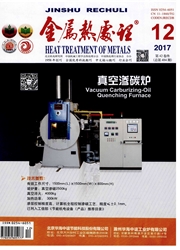

 中文摘要:
中文摘要:
研究了低合金化、中等强度、全片层γ-Ti Al合金Ti-45Al-2Mn-2Nb-0.8vol%TiB2在10 000 h、700℃大气热暴露处理下的热稳定性。研究发现,长期的大气热暴露导致合金通过渐进的α2层片消解、减薄模式实现α2→γ相变,且α2层片的分解、转化、消失的趋势较弱。相对于高合金含量的Ti-Al合金,该合金的枝晶偏聚不严重,α2层片不平衡分布的趋势较小。除极个别α2→β外,没有发生融合型α2+γ→β相变。热暴露10 000 h后,α2层片厚度约为热暴露前的一半,体积分数下降约为1/4,相应的"释氧脆化"和"B2+ω共生脆化"的影响较弱,使得合金的拉伸强度变化不大,塑形降低不严重,热暴露后的S-N疲劳强度反而增加了30%。疲劳强度的热暴露增强现象是因为热暴露导致的应力弛豫效应所致。长期的热浴浸泡导致样品表层的应力值降低,次表层的缺陷和微裂纹钝化,内部铸态α2-γ层片间的应力集中降低,这些均有利于提高合金抵抗疲劳微裂纹萌生的抗力。
 英文摘要:
英文摘要:
Thermal stability of a low-alloyed, intermediate strength and fully lamellar γ-TiAl alloy Ti-45Al-2Mn-2Nb-0.8vo1% TiB2 was studied at 700 ℃ in air for up to 10 000 h. It has been found that the phase transformation α2→γ occurs through gradual dissolution and thinning of α2 lamellae during exposure, and the rate of the dissolution and thinning is slow. The degree of dendritic segregation and uneven distribution of α2 lamellae is observed to be less severe when compared to the high-alloyed and high strength Ti-Al alloys. No combined phase transformation of (α2 + γ)→β3 occurs, except for occasional α2→β. The reduction in α2 lamellar thickness is about 1/2 and in volume fraction is about 1/4 after 10 000 h exposure. Effects of "oxygen-release embrittlement" and " B2 + to-caused embrittlement" are less significant because of the limited decomposition of ct2 lamellae. Accordingly, the tensile strength and ductility are barely changed. Moreover, the S-N fatigue strength is even increased by 30% after the exposure. The "thermal exposure strengthening" phenomenon of S-N fatigue strength is due to a stress-relaxation effect. Immersion of individual fatigue samples into a thermal bath for long-term actually reduces the surface stress value, and the subsurface defects and microcrack passivate, the stress concentration between casting α2-γ lamellae reduces. All of these are favourable for increase to resist microcrack initiation under cyclic loading.
 同期刊论文项目
同期刊论文项目
 同项目期刊论文
同项目期刊论文
 期刊信息
期刊信息
